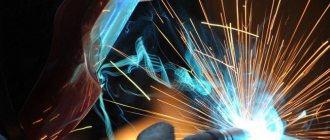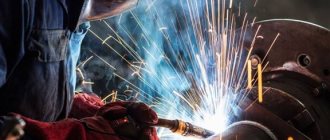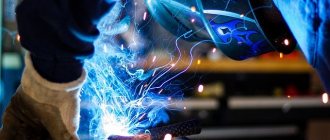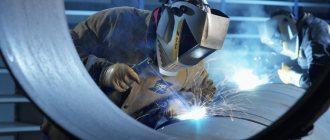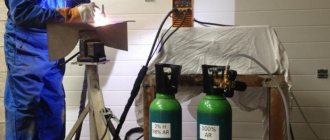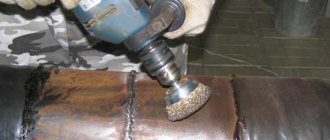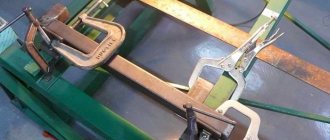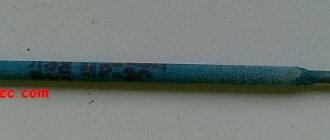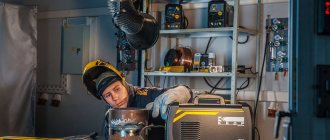- Home page
- •
- Articles on welding
- •
- How to choose electrodes for RDS welding for a beginner
In this article, we'll look at tips for selecting coated electrodes so you can buy the right consumables for the job.
To master RDS welding, you need a machine, protective equipment and consumables, as well as a lot of practice. We wrote how to choose welding equipment in a separate article, but here we will look at tips for choosing coated electrodes. This will help you buy the right supplies for a specific job.
Types and purpose of welding electrodes
With welding you can:
- connect metal parts;
- manufacture metal structures of any size;
- cut metal;
- eliminate cracks;
- cut round and shaped holes;
- weld metal to restore wear areas;
- carry out repairs and other types of work.
The industry produces many types of electrodes, about two hundred of them. Each of them is most effective within the limited characteristics of these works, so the choice of electrodes for welding is a very important step. It should be done after thoroughly studying the topic or with the help of specialists.
The criteria for selecting electrodes are the design parameters, characteristics and purpose specified by the product manufacturer. The main ones are:
- electrode brand;
- appointment;
- core diameter;
- type of electrode coating;
- electrode length;
- the magnitude of the working current;
- type of current and polarity of connection;
- composition of the central rod;
- welding position;
- special technological characteristics of the welding process.
Welding electrode sizes
You can currently find many types of electrodes on the market, which differ in the materials used for their manufacture and their sizes. Such welding rods for joining metals can be produced in various sizes. When choosing certain varieties of such surfacing materials, it is necessary to take into account their diameter, length, basic composition and type of coating. We will tell you in more detail how to choose the right length and diameter of the electrodes used.
Choosing the right diameter
The diameter of the rods, along with the composition of their alloy, is one of the most important parameters, therefore, when choosing one or another variety, you need to correctly determine the size you need, which will be the key to high-quality welding work. The thickness of the rod directly depends on the size of the base material. So, for example, if you need to weld metal sheets several millimeters thick, then you should choose electrodes that are small in size. If you are connecting metal parts with a thickness of several centimeters, and the depth of the seam will approach ten millimeters, then it is necessary to appropriately use thick surfacing rods for this work, which will ensure the strength of the connection. This characteristic is also influenced by the power indicator of the welding transformer. Different metals can differ significantly in their melting point, so it is necessary to correctly select the sizes of the surfacing materials used.
With the right choice, the melting temperature of the base surfacing material will be the same, which will allow both the electrodes and the base material to melt simultaneously. Consequently, the connecting seam will be uniform, high quality and durable. At the same time, you must understand that powerful transformers with high operating currents can instantly melt electrodes whose diameter is 2-3 millimeters.
If the diameter is chosen incorrectly, this can lead to a significant deterioration in the quality of the connection. If melting requires high power and high temperature, this can lead to the appearance of through holes in thin metal sheets. That is why it is necessary to correlate the thickness of the surfacing rods used with the characteristics of the base metals and their sizes.
Selecting the length of the electrodes
The length of the electrodes is not such a significant parameter for welding, however, in certain situations, the wrong choice can lead to a significant deterioration in the quality of the welding work performed. The length of the electrode depends on its thickness and the characteristics of the elements being welded. It must be understood that during the welding process, any interruption in the temperature treatment of the joint invariably leads to significant deterioration of the weld. Therefore, it will be necessary to select sizes of surfacing materials that will minimize or completely eliminate such welding interruptions, which will improve the quality of the work performed.
Short electrodes can be used in cases where long seams are not required. In this case, rods of 10 centimeters will be sufficient. But if you need to weld parts 30 centimeters or more in size, you need to choose electrodes that are appropriate in size, which will allow you to complete this work without interrupting welding. Please note that you should not purchase excessively long electrodes if you need to make short connections. In this case, if the length of the rods is chosen incorrectly, there is a risk of their breaking, which in turn leads to shedding of the coating, and without it the quality of the connection deteriorates significantly.
Currently, electrodes of various sizes can be found on sale. These can be either standard rods 10-15 centimeters long, or special varieties 30-40 centimeters or more long. It must be remembered that not all brands of electrodes are manufactured with a full range of sizes, which leads to some difficulties when choosing such a surfacing material.
Diameter and length of common varieties
- LB-52U. The manufacturer produces these brands with a diameter of 2.6 to 5 millimeters and a length of up to 35-40 centimeters.
- ANO-21. The length can be a maximum of 0.25-0.4 meters, with a diameter of 1.6-5 millimeters.
- MP3. This is a common type of surfacing rod and is available in a wide range. The diameter ranges from 2 to 5 millimeters, while their length reaches 45 centimeters.
- ANO-6. Buyers are offered three standard sizes, ranging from 3 to 5 millimeters. For electrodes with a diameter of 3 millimeters, the maximum length can be 35 centimeters. A five-millimeter surfacing rod has a maximum length of 45 centimeters.
Correct selection of electrodes
The diameter of the electrodes used for welding must be selected taking into account the thickness of the workpieces. In this case, the composition of the surfacing and base material should be as similar as possible, which will allow for a uniform, strong connection. It is also necessary to take into account the melting temperature of the parts being connected, which must be the same. In the event that metal products with a thickness of 1-3 millimeters are welded, then two-millimeter electrodes and an operating current of the inverter from 25 to 100 Amperes can be used. If you are welding parts with a thickness of 3 to 6 millimeters, then electrodes with a thickness of 3-4 millimeters can be used. The optimal operating current is 150-200 Amperes. Welding surfacing materials with a diameter of more than six millimeters can be used to weld metal with a thickness of 10 centimeters or more.
Important. Before starting welding, you should evaluate the condition of the coating, which should not be damaged, which can significantly deteriorate the quality of the weld.
The length of the electrode is important in cases where it is undesirable to interrupt the welding process, which can lead to a deterioration in the quality of the work performed. For example, when repairing sealed containers for high-pressure pipelines, interrupting the welding process and using several rods to weld one joint can lead to a significant decrease in reliability. As a result, expensive and complex repairs will be required in the future. There are also certain metal alloys for which interruption of welding will invariably lead to deterioration in the quality of the joint. That is why, when choosing the length, it is necessary to proceed from the length of the weld and select the rods in such a way that their size is larger than the weld.
By choosing the right welding rods, taking into account their length and thickness, you can ensure a high-quality connection, while the resulting seam will have the necessary decorative effect, mechanical strength, durability and corrosion protection.
svarkagid.com
Purpose
The brand of the electrode, as a rule, encrypts its purpose. For example, product types:
- UONI - designed for welding parts at low temperatures;
- ANO-21 - for performing work with thin (up to 4 mm) parts operated under low pressure;
- MP-3S - for welding rolled parts and medium-carbon steels up to 20 mm thick;
- LEZ - for surfacing worn parts;
- inexpensive universal-use OZS-12 electrodes are recommended for welding carbon steels and are easy to use;
- rutile products of the ANO-4 grade are used for welding low-alloy and low-carbon steels; work on both direct and alternating currents; They cook metal contaminated with rust well, have a stable arc, and are easily cleaned of slag.
Experts distinguish between electrodes for welding, tacking, surfacing and cutting. Universal products are in great demand, saving a lot of time when performing various types of work.
Selecting current depending on the diameter of the electrodes
Thin metal, no more than 1 mm thick, is welded with 1 mm electrodes, and the current strength is set to the minimum possible values, in the range of 10-30 A. When welding thicker metal, up to 2 mm, electrodes of a slightly larger diameter are used, 1. 5 or 2 mm. The current strength for welding with these electrodes is set in the range of 30-50 A.
A 3 mm electrode is used to weld metal up to 4 mm, and the current on the inverter is set to 60-120 A. For welding metals over 10 mm thick, much thicker electrodes are already used - 4 and 5 mm. For their normal use, the welding machine must be set to a current of more than 120 A.
Diameter
The choice of electrode (core) diameter is determined by the thickness of the parts being welded and the maximum current of the welding machine used. The higher they are, the thicker the connected elements can be.
All three parameters are dependent on each other. Their values are indicated in special tables, which are convenient to use before work and purchasing electrodes. So, for parts with a thickness of 3-4 mm, you need to use electrodes with a diameter of 3 mm with adjustable operating current within the range of 80-160 A.
Coating of electrodes
The core coating is a solid composition, a kind of flux, designed to protect the molten metal from the harmful effects of oxygen, which, when it enters the liquid metal, forms oxides that deteriorate the quality of the connection.
Another function of the coating is to thermally insulate the melt to delay the solidification time (so that harmful gas and non-metallic inclusions have time to escape from it). Modern electrodes use several types of coating. The main ones are basic (in the marking of electrodes, indicated by the letter “B”) and rutile (letter “R”).
Basic coating
It is known that it contains calcium salts - carbonate and fluoride. Its advantage is considered to be a low hydrogen content. Typical representatives of electrodes with basic coating are UONI products. Their coating ensures a high-quality seam, both in appearance and in technical indicators: ductility, strength, impact strength.
The electrodes do not form crystalline cracks inside the seam, therefore they are recommended by specialists for critical welding operations and for products operated in harsh climatic conditions. They can be used when welding in any position except vertical.
Where and how are welding electrodes used?
Welding electrodes are used both in home construction and in the construction of mass industrial facilities.
In both cases, as a rule, the same types of consumables are used.
They are always purchased for a specific welder, taking into account operating conditions and technological parameters.
During the welding process, the rods melt and melt the joints of the metal elements, resulting in a strong molecular bond between the latter.
Using welding electrodes you can perform:
- Connection of two metal parts. This, in principle, is their main purpose.
- Welding cracks.
- Cutting metal structures and individual elements.
Also, welding electrodes are often used for surfacing metal on various parts that, during operation, have been subject to wear and have lost their original geometric dimensions.
Welding rods can be worked in different positions, depending on their type:
- Bottom location of the welding joint - used in cases where there are no special requirements for the connection. It is considered the most productive and optimal way. The electrode is positioned vertically, and the connecting surfaces are positioned horizontally.
- Horizontal arrangement – horizontal seam, horizontal position of the electrode, vertical position of the elements being welded.
- Vertical – vertical seam, vertical arrangement of welded elements, horizontal positioning of the electrode.
- Ceiling – vertical arrangement of the electrode, horizontal placement of the connected elements. This is the most difficult type of seam to make, since the master welds from below, which is why the melt can flow down, bypassing the weld pool.
Among other things, there is boat welding.
Here the elements to be welded are located at an angle relative to each other.
Welding is carried out mainly in the lower position, thereby increasing the speed of work.
As for the positioning of the electrode itself, during operation it can be located at a 90-degree angle with respect to the seam, as well as at a 30-60 degree tilt forward or backward.
Rutile coating
Rutile is titanium dioxide. In addition to it, the coating contains silicon and oxygen.
Rutile coating is characterized by the following properties:
- formation of a high-quality seam at any spatial position of the electrode;
- stable arc burning;
- minimal splashing of melt and coating;
- possibility of welding on both direct and alternating currents;
- possibility of welding rusty and dirty parts;
- quick and easy ignition of the electrode;
- easy removal of slag.
Current source
To weld metals with electrodes, welding transformers, rectifiers, inverters and other devices operating in manual arc welding mode are used. The inverter is widely used due to its compactness, light weight and wide capabilities.
It provides operation on both direct and alternating current, and its light weight is explained by the fact that voltage transformation is performed at a frequency not of 50 Hz, but of 100 kHz, for which the size and weight of the transformer core is reduced by an order of magnitude.
When welding with direct current, the polarity of the connection matters. With direct polarity, the ground (welding part) is connected to the “+” of the source, and the holder with the electrode is connected to “-”. With reverse polarity, the opposite is true. With direct polarity you can weld thin parts, and with reverse polarity you can weld massive parts.
When selecting electrodes, using the table and data on the welding machine, you can determine whether the source can provide the required amount of current.
How to choose the right electrodes for inverter welding - all characteristics and types
The replacement of old transformer models of welding machines with new inverter ones has made some adjustments. In particular, the requirements for consumables have increased. Therefore, before starting welding work, it is important to choose the right type of electrodes. To do this, you need to know their characteristics and types.
Electrodes – for inverter or transformer devices?
There is an opinion that inverter welding machines require a special type of electrodes. Some sellers actively promote this misconception, earning additional cash bonuses. To make things completely clear, it is worth considering the technical parameters of such electrodes.
Type of current
Unlike transformer models, inverter devices operate on direct current. Although there are a number of models that offer a combined mode. All manufacturers indicate the type of current on the electrode packaging. Therefore, according to this characteristic, they can successfully perform their functions for all types of devices.
Polarity
This is also a very controversial distinction. For alternating current this term is absent altogether, but for direct current it is only important to connect the electrode to the desired terminal. The recommended polarity is also indicated on the package.
Additional operating modes
To create a high-quality seam, modern welding machines have several auxiliary functions. However, they in no way affect the choice of consumables.
As a result, we can say that there are no fundamental differences between electrodes for inverter and transformer welding machines. But this does not mean that you can take any pack, focusing only on the indicators described above.
The choice of one or another type of electrode should be determined by the welding material, its parameters and geometric dimensions.
Characteristics
The main parameters for welding machine consumables are described in detail in GOST 9466-75. Its points are constantly being improved, according to the emergence of new types of equipment and materials. Currently, the following markings have been adopted, characterizing the type of processing material:
- U - designed to work with carbon and low-carbon types of steel.
- L – for alloy steels of structural type.
- G – alloy steel with heat-resistant additives.
- B – high-alloy types of steel for special purposes.
To ensure that the exposure time on the metal during welding is as long as possible, the electrodes are coated with a special ferrite powder. Thanks to this, operational properties are improved - re-ignition of the arc is simplified, and the cooling rate of the metal increases. If the composition contains more than 20% iron powder, then the nomenclature designation “F” is added.
However, in addition to this factor, the composition of the electrodes should be taken into account. It is the main factor when choosing - the characteristics of the manufacturing material directly affect the quality and specificity of the operation of the electrodes. GOST defines the following types of coating of electrode surfaces:
- A – “acid coating” with a high content of silicon, manganese, iron.
- B – the use of calcium fluoride and calcium carbonate allows you to work with large sections of workpieces.
- C – the base contains organic materials – cellulose, flour. During operation, external arc protection is created with the simultaneous formation of a thin layer of slag. This type is often used for welding metal of small thickness.
- R - to obtain high-quality seams with a minimum coefficient of spattering of straightened metal, rutile is added to the composition. This makes it possible to form a stable welding arc.
- P – other additives that can be used for highly specialized materials.
The next factor is the thickness of the metal being welded. The diameter of the electrodes depends on this parameter. The table shows the recommended electrode sizes.
Each pack must have a designation of the type of electrodes. The figure shows a detailed explanation of each component of the product nomenclature number.
Manufacturers and prices
As mentioned above, depending on the type of material being welded, the appropriate brand of electrodes should be selected. In practice, professionals have long determined the optimal types for themselves. The table shows the average cost per kilogram of these electrodes from various manufacturers.
If you do not have the proper experience in working with welding equipment, then before choosing electrodes it is best to consult with professional welders. They know all the subtleties and nuances of each type, but at the same time, personal preferences that inevitably form during the work process should be taken into account.
ismith.ru
Welding position
The spatial position of the electrode is also included in its marking. The number 1 denotes electrodes that are used for welding only in the lower position of the part (electrode on top).
The number 2 marks products used with a horizontal or vertical seam (ceiling is excluded).
Number 3 is used for ceiling electrodes (the electrode rests on the part from below). The welder must take these markings into account to avoid a poor-quality weld or injury.
The thinnest welding electrodes
The size of the electrode diameter is one of the main parameters when choosing, since it is necessary to select consumables with a thickness approximately equal to the base metal. Naturally, sooner or later you have to deal with thin sheets, the welding of which is not only a complex technological process that requires a lot of experience, but it is also impossible to carry out without special materials and tools. In most cases, they try to connect them using gas welding, but if this is not possible, then they have to use the thinnest welding electrodes.
Thin welding electrodes
Not all brands have materials that can satisfy this request, since in some cases the thickness starts from 2 mm. Thin ones can be called those that are less than 2 mm in diameter. Electrodes for thin metal almost completely maintain the ratio of the amount of coating in relation to the amount of material on the rod. As a rule, this is one third of the total mass. Such things are more difficult to manufacture and they are not used as often. With the advent of small home inverters that have a short operating range, thin welding electrodes have become more popular, since the power of that equipment could melt a maximum of 3 mm of filler material.
Electrodes for welding
The thinnest electrodes for arc welding are quite difficult to use, since their melting rate is much higher than that of standard ones. To do this, special modes should be selected, but this may not be enough to obtain high-quality results. Practical experience is needed here, as there is a high risk of burning the base metal. There are also a number of requirements for the equipment, for example, the holder must securely fix the electrode. The welding transformer must have fine adjustment so that you can accurately select the desired current strength. The speed of the process is much higher than in a standard situation.
The thinnest electrodes for arc welding
The protection provided by the coating is relatively small, due to the thin layer of coating. But this may be enough, since the weld pool is also small. It is advisable to use metal flux to improve welding properties and protect the seam. Here you need to carefully regulate the balance of the welding depth so that the deposited metal adheres to the base metal, but there are no holes. It is also worth considering that when welding thin metal there is a possibility of thermal deformation. To prevent this from happening, the seam should not be made over its entire length at once, but in small strips. You also need to make tacks along the entire length so that everything does not bend.
Welding metal with a thin electrode
Electrodes for welding metals 1 mm are narrow-profile and are rarely used by professionals. But they have no alternative, so they must be in a professional’s arsenal. The main thing is to select them correctly, and then use them according to technology so that there is not a large amount of defects.
Advantages of thin electrodes
- This is the only consumable that can be used for arc welding of thin products without the great risk of burning out the workpiece;
- Electrodes for welding thin metal with an inverter have a relatively low cost, so you can always buy a large amount of material;
- In terms of their physical properties and composition, they are almost as good as the thicker representatives of the brand;
- The electrodes are quickly prepared, since drying and calcination takes a relatively short amount of time.
Disadvantages of thin electrodes
- Electrodes for welding thin metal with an inverter are not intended for working with thick parts, as they will not be able to weld to the required thickness;
- There are difficulties with the work, since the welding technique differs from the usual one;
- Due to their size, they run out quickly and you have to frequently change consumables;
- An insufficient layer of coating makes the protection of the weld pool not so reliable;
- Often it is necessary to use additional consumables;
- Not all brands are produced in such a small version, therefore, sometimes difficulties arise with the selection.
Specifications
The technical characteristics of the electrode depend on what elements are included in its composition, as well as on the physical properties of the metal from which the rod is made and what is included in the coating.
| Test temperature, degrees Celsius | Tensile strength, N/mm2 | Relative extension, % | Impact strength, J/cm2 | KCV>34 J/cm2 at temperature, degrees Celsius |
| + 20 | 460 | 18 | svarkaipayka.ru |
Calcination of electrodes
Coating of electrodes requires tightness during storage, but this condition is not met everywhere. The sharp edges of the rods, as a rule, break the tightness of the plastic packaging already during the first transfer of packs. Thus, by the time of purchase, the electrodes are saturated with excess atmospheric moisture.
In this condition, due to the danger of obtaining a poor-quality seam and the possibility of too much metal spattering, welding cannot be performed with them. The electrodes need to be dried. The manufacturer gives clear recommendations regarding process parameters, setting drying time and maximum temperature. It usually does not exceed 260 ºС.
How to determine the quality of electrodes when purchasing?
The best option would be to test several electrodes from the purchased batch in the welding workflow. If this is not possible, you need to pay attention to the following factors:
- shelf life of products;
- name of the manufacturing company (for experienced welders this is important information);
- quality of coating in terms of uniform thickness of application around the rod, absence of crumbling.
If during testing there are signs of excessive moisture, the electrodes should be dried and the test repeated.
In order for the welding of parts to be carried out in accordance with all the rules of the regulations, and the quality of the seam not to be criticized, it is extremely important to study welding technologies well. The choice of electrode type is an integral part of this knowledge, which needs to be constantly replenished and improved.

